Now that AI has advanced so far, it’s difficult to tell which content was developed by humans and which by machines. This shift can be seen across the board, from AI-powered writing assistance to generative language models like ChatGPT. While this development opens up exciting new possibilities, it also raises questions about the veracity and originality of the content we encounter. The need for reliable AI content detection solutions is greater than ever before as the distinctions between human and AI-generated material continue to blur.
ChatGPT Detectors and The Increase in AI Content and the Requirement for AI-Based Content Detection
The advent of AI has completely altered the way in which we engage with media. Artificial intelligence (AI) writing has spread to additional areas, from blog posts and articles to captions on social media. Because of this technical development, organizations, producers, and individuals can crank out a ton of information in a short amount of time. One potential drawback to this ease of use is the difficulty in telling the difference between content created by humans and that created by artificial intelligence.
As the use of AI for writing has increased, so has the need for AI-powered content analysis methods. Natural language processing (NLP) models and other cutting-edge AI technologies are used by these apps to assess information and establish whether it was made by people or computers. It is important to find the best AI detection tool for your needs among the many options available on the market.
List of Best ChatGPT AI Text Detectors
1. Originality.AI
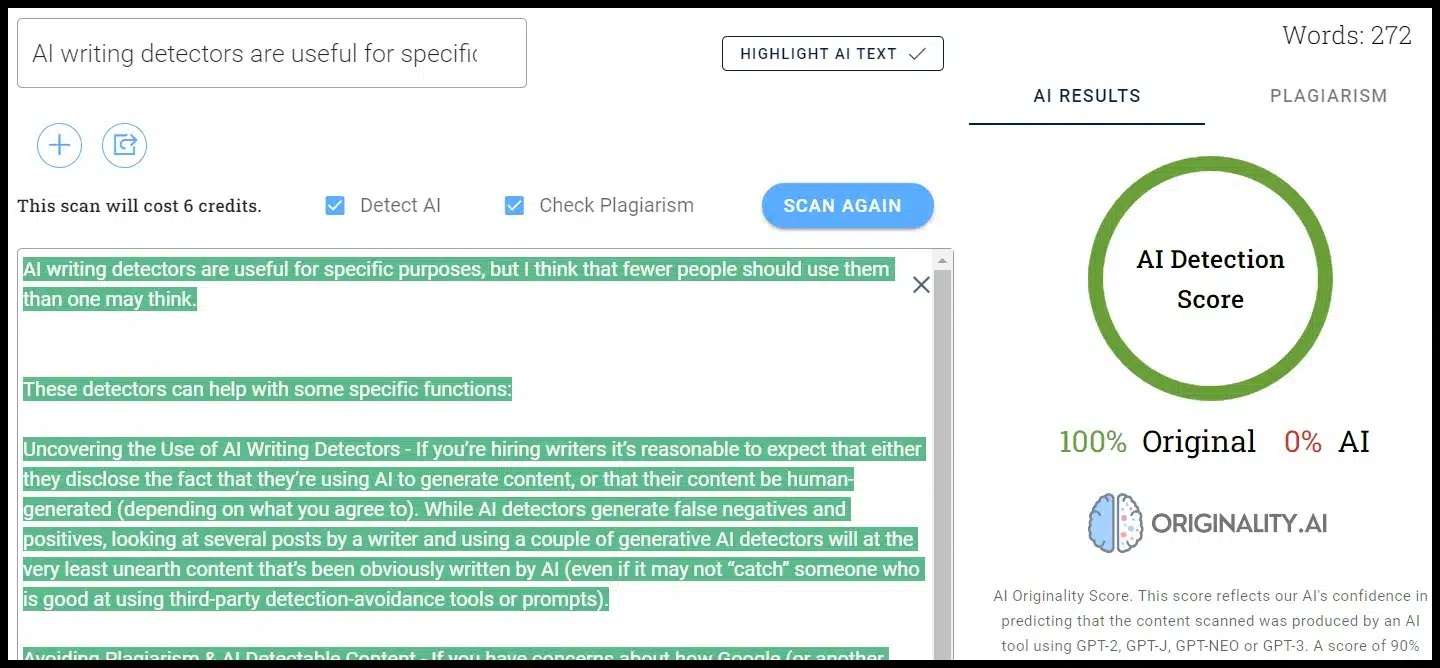
One with originality.AI is a paid application that is touted as “the most accurate AI content detector and plagiarism checker built for serious content publishers.” AI was built for content publishers that take their work seriously.
One credit is equal to scanning one hundred words and costs one penny. In addition to the AI scanner, it also has a scanner that checks for plagiarism.
As can be seen from the chart that is located above, this AI scanner is the only one that can determine with one hundred percent certainty that the material that originated from humans originated from humans and that content that originated from AI originated from AI (while also being correct in all instances).
Hive Moderation, which will be covered later in the paper, came to essentially the same conclusion with a 0% AI score for the human material and a confidence level of 99.9% that the two texts written by AI were really generated by AI.
In addition to having a Chrome extension and an overall score, Originality also takes into account.AI now includes a function that highlights in the content that you paste the exact areas of the content that it anticipates will or will not be AI.
Personally, detecting artificial intelligence is the purpose for which I make the most frequent use of this instrument. Checking the work of freelance writers that our company collaborates with for instances of AI and plagiarism is the use case I perform the most frequently.
2. Jasper
In the arena of artificial intelligence content identification, Jasper AI is often regarded as a forerunner. Jasper AI is able to reliably recognize content that was generated by ChatGPT and other AI models thanks to the excellent detection model it possesses. Users are given the ability to make educated conclusions regarding the validity of the information thanks to the tool’s provision of an overall score that indicates the possibility that the text was generated by AI.
3. Writer
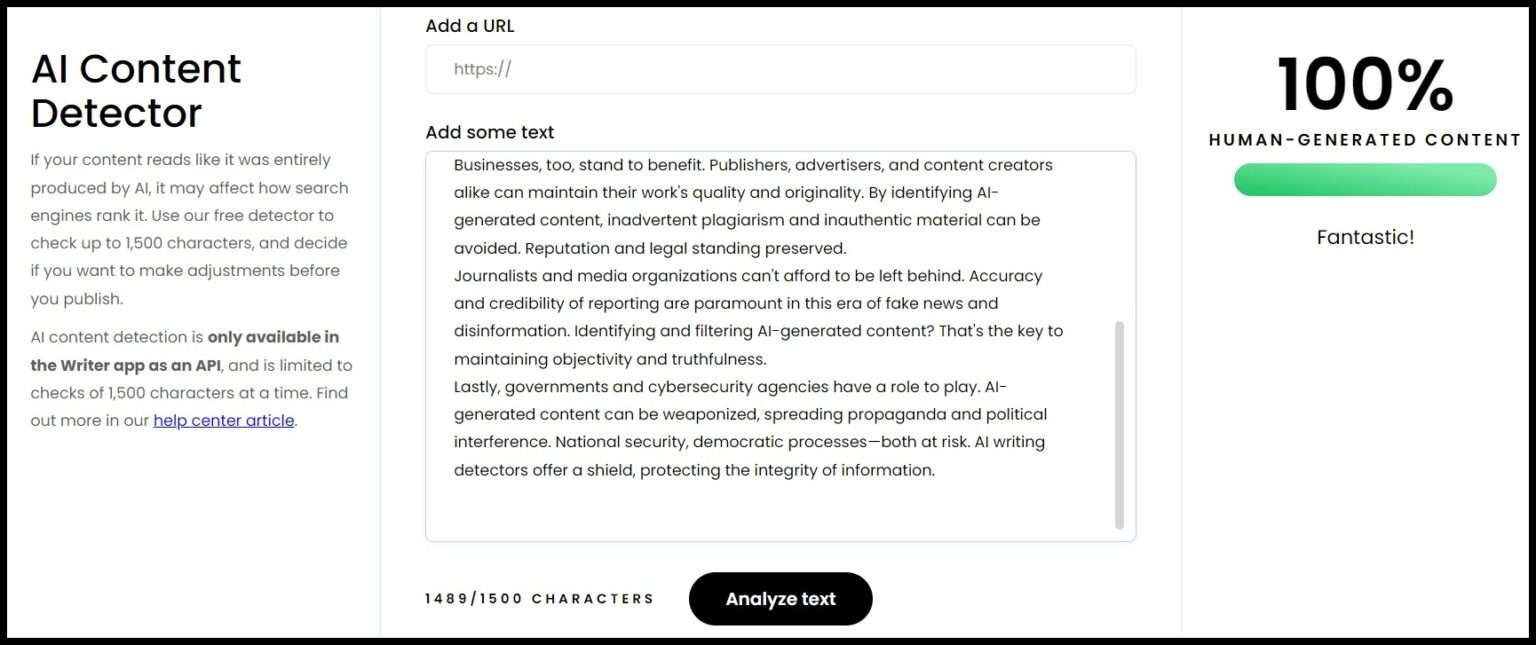
Writer provides a detector for free, but its functionality is limited to the first 1,500 characters, beyond which API access is required.
This technology, in essence, believed that all of the contributions were fairly likely to have been generated by human beings.
Writer is an AI writing platform that also includes a free content detector that lets users input a URL to check for inappropriate content.
This program does not include a function that checks for plagiarism directly, and while it does provide you with a score overall, it does not indicate which sections are more likely or less likely to have been generated by AI.
4. Copyleaks AI Content Detector
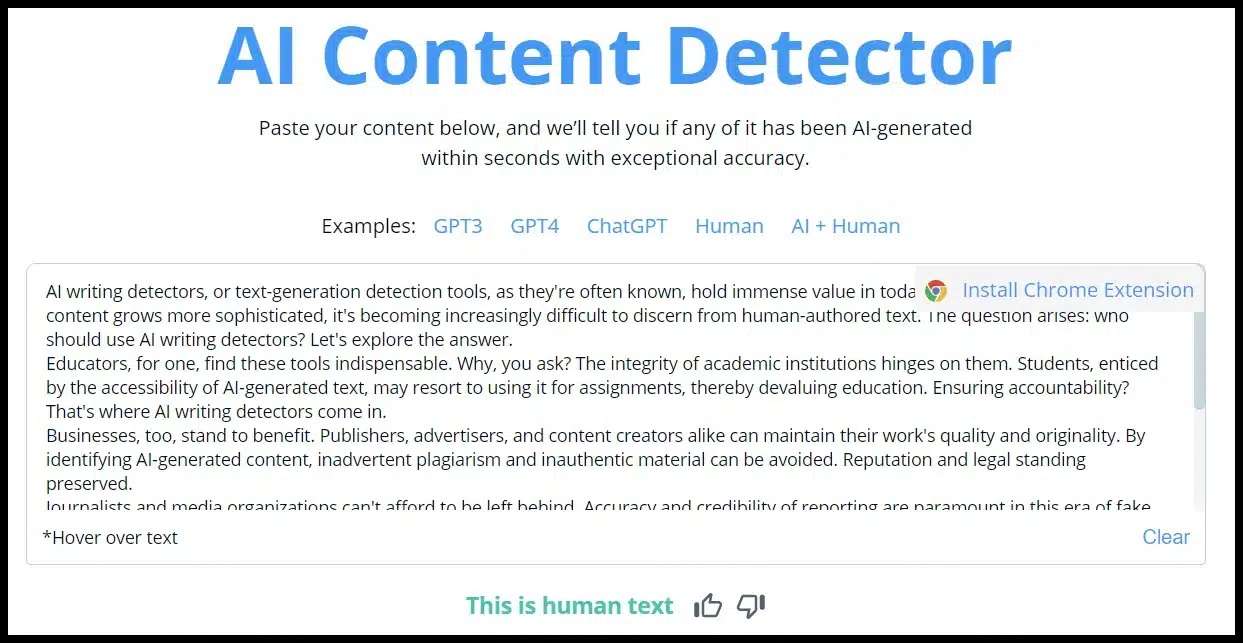
A number of intriguing capabilities are included in the Copyleaks AI Content Detector, including the following:
It provides you with an overall verdict (human or artificial intelligence).
When you move your cursor over certain words, you will see a percentage that indicates the possibility that the text was written by a person rather than an AI.
It demonstrates how the tool should be used by pre-loading it with examples that cover a variety of GPT and human outputs.
There is an extension available for Chrome.
The program is free to use, and it also includes a plagiarism detector, although a single scan won’t check for both at the same time.
It accurately identified a significant portion of the human-generated content as being human, and it accurately identified a significant portion of the AI-generated content as being AI. On the other hand, it wasn’t always sure of itself and got some of the details wrong in certain places.
5. GPTZero
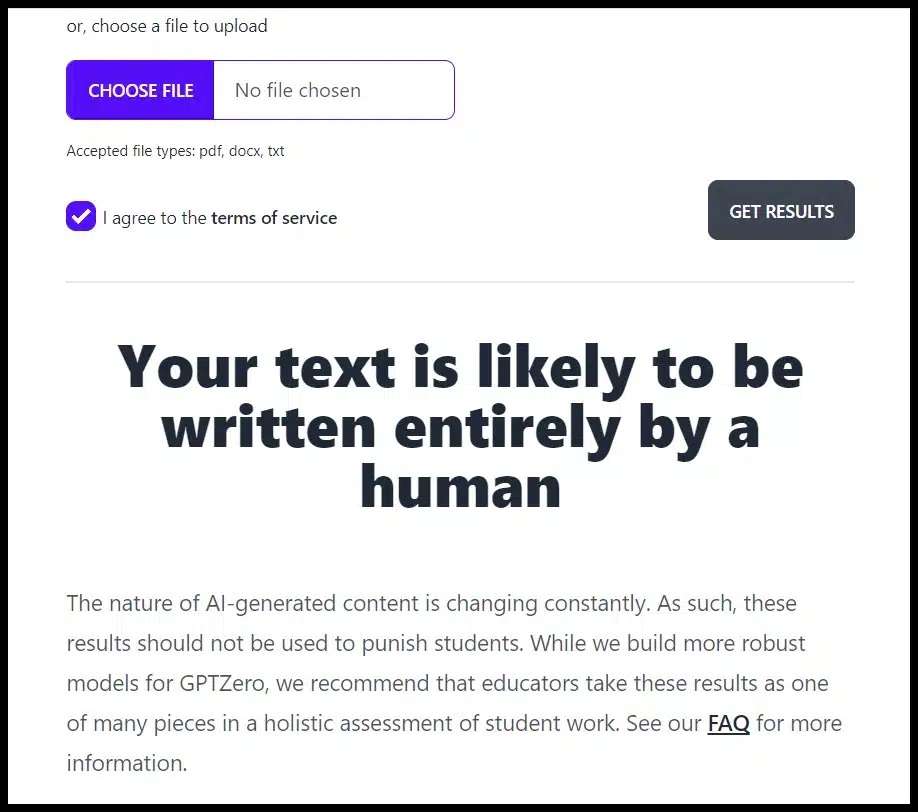
There are both free and paid versions of GPTZero. The free edition provides you with a score and comes with various examples that are pre-loaded.
The premium version also includes a tool to check for instances of plagiarism, an emphasis on content generated by artificial intelligence, and the capacity to upload numerous pieces of content at once in bulk (a feature that, like to many of these other tools, was developed with a classroom setting in mind).
The website does not include a price list for the paid products; nevertheless, there are forms that can be filled out to request access to the paid tool as well as the API.
The basic version of the software determined that all three of the writing samples we provided were most likely produced by humans.
6. Content at Scale’s AI Detector
The Content at Scale AI Detector is free and offers a score with a breakdown of different elements within the content (predictability, probability, and pattern) and pre-populated examples.
No plagiarism detection option exists, and individual content sections aren’t highlighted.
Content at Scale rated all three samples as 92% human or higher.
The human did have the highest human percentage, followed by the prompt-modified GPT content and the content generated by the simplest prompt.
7. ZeroGPT
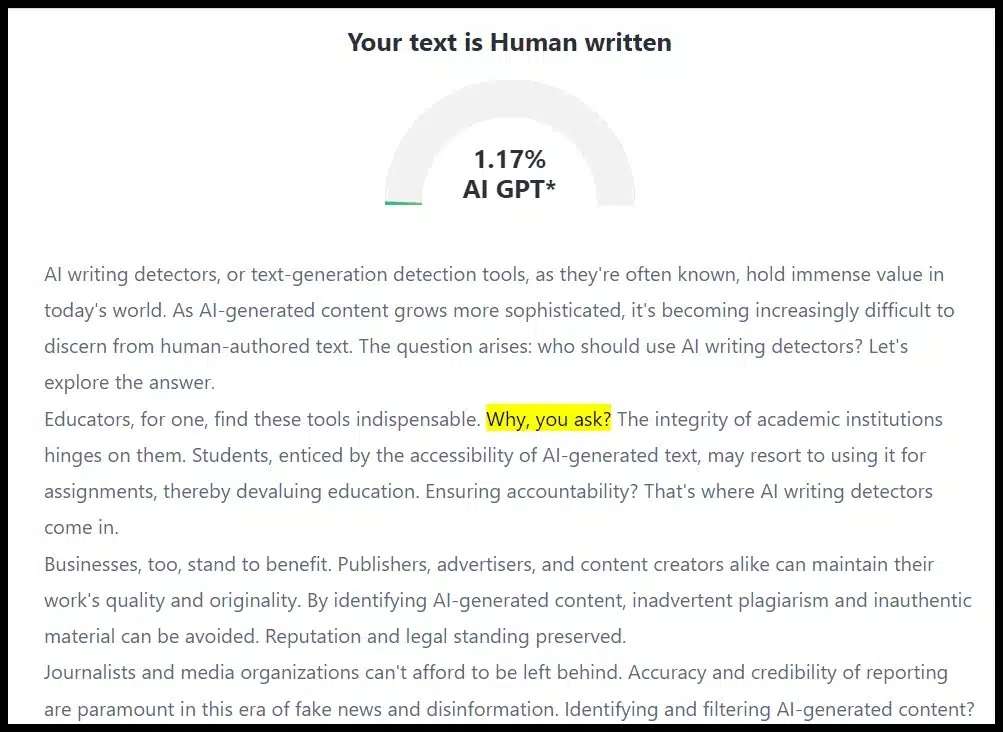
The ZeroGPT tool is a free resource that provides an overall score as well as highlighting, however it does not identify plagiarism.
The tool yielded low percentages of likelihood based on AI across the board, but it returned low percentages overall. It closely corresponds to the human-ness of the samples, with the sample made by humans receiving the lowest proportion of artificial intelligence, followed by the burstiness / confusion prompt, and then by the simpler prompt.
8. GLTR – Giant Language model Test Room
The “Giant Language model Test Room,” often known as GLTR, is a free tool that was developed by Hendrik Strobelt, Sebastian Gehrmann, and Alexander Rush from the MIT-IBM Watson AI lab and Harvard NLP in conjunction with one another.
The software provides a score for the text as a whole, but its primary function is to determine if each word in the text was one of the ten, one hundred, one thousand, or outside of the one thousand most likely words to be generated by AI based on the preceding context in the text. This site does not have a tool that checks for plagiarism.
The tool returned a greater total of “likely words” and especially likely words in the top 10 for the text that was generated by the more straightforward query.
In spite of this, the distribution was the same for both human participants and additional copies of the prompt in this limited test.
9. Investigator of ChatGPT
As its name suggests, ChatGPT Detective was developed primarily to identify content that was generated by ChatGPT and other models with comparable functionality. Users are able to determine whether a piece of text was authored by a person or was generated by AI with the assistance of this tool, which claims an accurate AI detection model. Users are able to effortlessly paste their material and acquire detection results in a timely manner thanks to its user-friendly interface.
10. DetectoGuard, powered by OpenAI
OpenAI DetectoGuard makes use of cutting-edge artificial intelligence technologies in order to recognize AI-produced text. This includes the material that is generated by models such as ChatGPT. Users of the tool are provided with an AI probability score that indicates the possibility that the specified text was generated by artificial intelligence (AI). Because it integrates with Chrome extensions, it makes content analysis while surfing the web completely effortless.
Important Note
The most important things we learned after evaluating 16 different AI and ChatGPT content checkers
Again, it is critical to qualify the significance of my primary findings in this section due to the fact that three brief writing samples are a very tiny sample size from which to draw definitive conclusions about the individual tools. Having said that, I did discover a few intriguing trends associated with AI writing detectors in general, and they are as follows:
Calibration: The majority of the tools determined that all three writing samples were either extremely likely or extremely unlikely to have been created by humans. Understanding how a tool is calibrated can help decide how beneficial it is because different tools are likely to be “harder” or “softer” graders when it comes to evaluating content based on whether it was created by humans or AI.
unique features: Among the tools, some of the unique features included emphasizing specific areas with the possibility of being AI as opposed to human, bulk uploading, plagiarism detection, having a Chrome extension, and highlighting specific sections with the likelihood of being AI.
Free versus premium versions of all of the tools included on this page, with the exception of Originality.AI was available in at least some free versions. However, the tools that offered the most accurate findings and the greatest number of “rare features” tended to be the premium versions of the products.
Assessment of Artificial Intelligence Detection Methods
Because both false positives and false negatives can have serious repercussions, it is crucial that AI detection technologies are as accurate as possible. Incorrectly identifying human-written content as AI-generated is an example of a false positive, whereas mistaking AI-generated content for human-written language is an example of a false negative. We put these tools through their paces by running a battery of tests on a wide variety of content to determine how well they performed.
Methodology
We gathered information from many different sources, such as blogs, social media, and news stories. Both human and machine-made content were included. We then analyzed the material with the aforementioned AI identification techniques and rated the effectiveness of the tools based on their ability to correctly determine the source of the text.
False positives and false negatives: addressing your worries
Content producers, marketers, and businesses all stand to lose in the event of a false positive or negative. Human-written content may be incorrectly identified as being produced by AI, leading to unjustified worries. A high false negative rate, on the other hand, could lead to problems with the originality and validity of AI-generated content going unnoticed.
Developers of AI detection tools are constantly iterating on their models to optimize for both high detection accuracy and low false positive rates. Due to the dynamic nature of AI technology and content generation methods, it is difficult to achieve a flawless detection rate, and users of such tools must be aware of this.
Advantages of AI Content Detection Tools
- Time Efficiency: AI content detection tools can quickly analyze a piece of content and provide instant results, saving valuable time for content creators and marketers.
- Accuracy: While not infallible, these tools have proven their capability to accurately distinguish between human and AI-generated content with a high degree of precision.
- Integration: Many AI detection tools offer browser extensions or APIs, enabling seamless integration into various workflows, including content creation, marketing, and research.
- Wide Applicability: These tools can be used across different types of content, from written articles to social media posts, ensuring comprehensive coverage.
Frequently Asked Questions About AI Content Detection
1. Can AI detection tools differentiate between various AI models, such as ChatGPT and others?
Yes, advanced AI detection models, like those mentioned above, are designed to differentiate between content generated by various AI models, including ChatGPT.
2. Can I use AI detection tools for free?
Many AI detection tools offer a free version with limited features. However, to access advanced functionalities and achieve higher accuracy rates, users often opt for paid versions.
3. How do AI detection tools determine the likelihood that the text is AI-generated?
These tools leverage complex AI algorithms and detection models trained on vast datasets to assess linguistic patterns and markers associated with AI-generated content. The calculated probability score reflects the likelihood of the text being AI-generated.
4. Are false positives and false negatives common?
While AI detection tools strive to minimize false results, false positives and false negatives can still occur due to the inherent challenges in accurately detecting AI-generated content. However, the top AI detection tools continually refine their models to reduce such occurrences.
The Future of AI Content Detection
As AI technology continues to advance, AI content detection tools will play a vital role in maintaining the integrity and authenticity of digital content. From businesses safeguarding their brand reputation to educators ensuring academic integrity, the applications of AI detection technology are far-reaching. As developers refine AI detection models and integrate them with emerging technologies, we can expect even greater accuracy in detecting AI-generated content.
In conclusion, the rise of AI-generated content has prompted the development of sophisticated AI content detection tools. These tools, including Jasper AI, ChatGPT Detective, and OpenAI DetectoGuard, offer accurate and efficient ways to distinguish between human and AI-generated text. While challenges such as false positives and false negatives persist, the progress in AI detection technology is promising. As content creation continues to evolve, so too will the capabilities of AI content detection tools, ensuring a harmonious coexistence of human and AI-generated content in the digital landscape.
